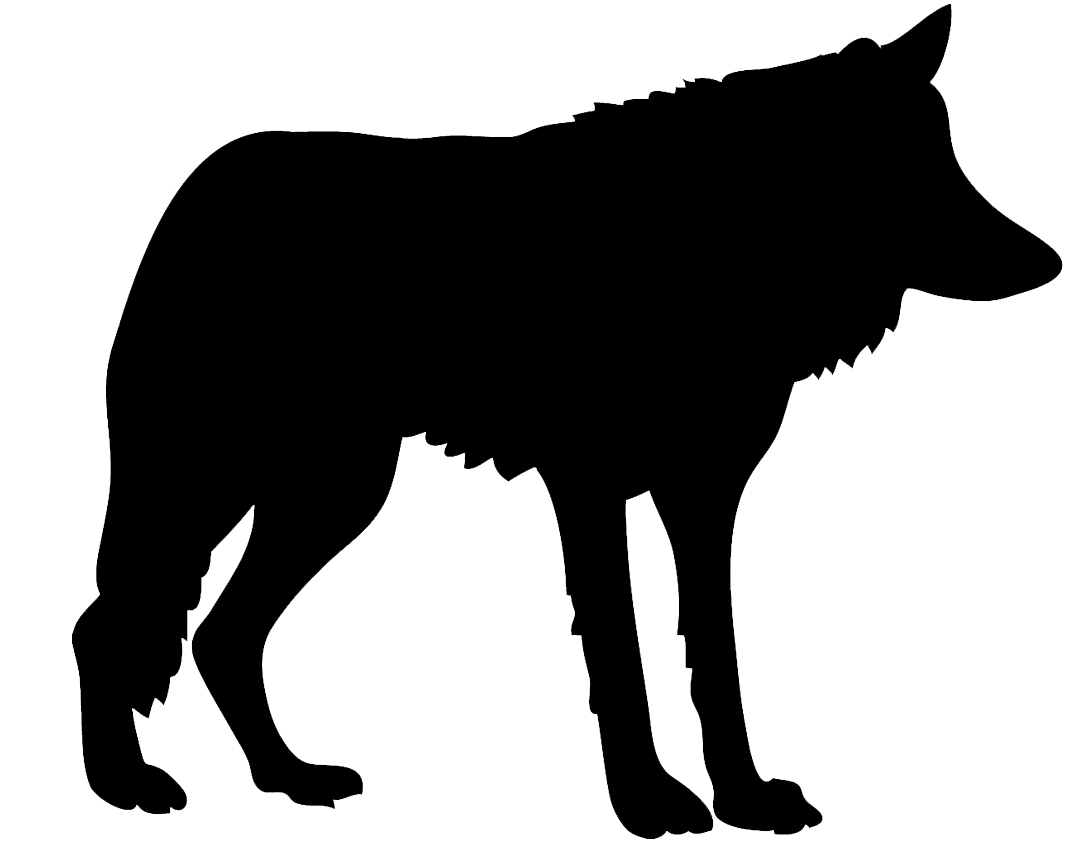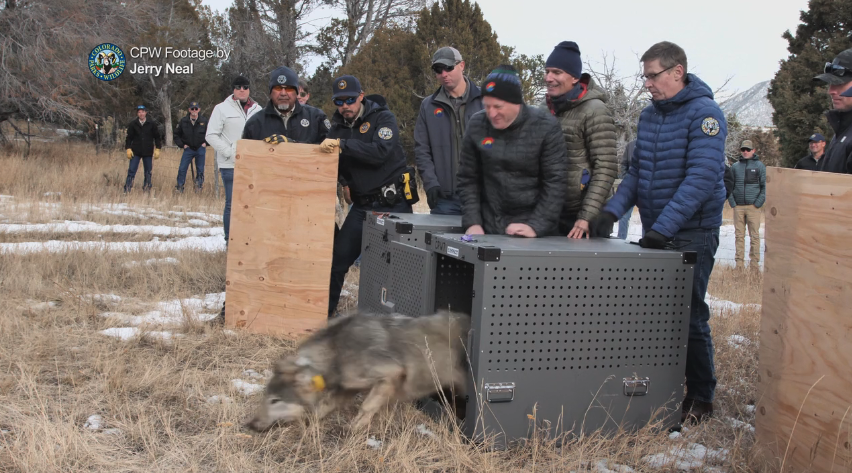Colorado Parks and Wildlife (CPW) provided a detailed list of its efforts — both what is in place and what it is working to bring to fruition — ahead of the next round of gray wolf reintroductions this winter at Thursday's CPW Commission meeting.
Since the final Colorado Wolf Restoration and Management Plan was published in May 2023, CPW has said it will release 10 to 15 gray wolves per year for a total of 30 to 50 wolves over three to five years.
Many lessons were learned after the initial December 2023 wolf release, and a spokesperson shared those details on Thursday. In addition, the president of the Middle Park Stockgrowers Association presented a petition, which was filed in September, that asked for a delay in future wolf reintroductions until depredations are addressed and mitigation tactics are fully implemented.
Denver7 listened to the full meeting to hear from both the rancher's point of view, as well as CPW staff. Below are the points that the groups said were most important, what still needs to be done, and what comes next.

CPW REVIEWS ITS EFFORTS AHEAD OF WINTER WOLF RELEASE
CPW has been preparing for the upcoming wolf release, which it is anticipating to do in early 2025, in a myriad of ways, explained CPW Deputy Director of Policy Reid DeWalt.
One of the main focuses this year — aside from the complicated logistics of trapping wolves in British Columbia, transferring them to Colorado and releasing them — is significantly increasing communication with the counties where the releases will happen.
In an exclusive interview with Denver7 in September, CPW Director Jeff Davis said communication was a "big lesson" from the December 2023 release.
As a nod at how CPW is listening to impacted communities, DeWalt explained how after meeting with county commissioners of four counties where wolves may be released this winter about one week ago, CPW decided to remove Rio Blanco County from the list. He cited limited release sites in the county, proximity to livestock and an elevated risk of conflicts.
He said Thursday that he hopes this shows that CPW is "agile enough" to make changes when warranted.
“We have learned a lot and we’re doing things differently already," said CPW Director Davis on Thursday.
DeWalt said CPW has made "a lot of progress" on free site assessments — which detect any weak spots and the best coexistence techniques for that specific area — and he noted that the agency has offered those since the beginning of the reintroduction. These assessments are voluntary and ranchers have requested them sometimes as a proactive measure, and other times after a depredation. Either way, it helps CPW understand where concerns arise and how to allocate resources and staff.
Colorado agencies — including CPW, Colorado Department of Agriculture (CDA), U.S. Department of Animal and Plant Health Inspection Service's Wildlife Services, and Colorado State University Extension — have also held free workshops on using non-lethal methods to keep wolves away from livestock, he said, which Denver7 reported on in October. At those trainings, about 20% of attendees signed up for free site assessments, said Wayne East, ag wildlife manager for the CDA. He spoke alongside DeWalt on Thursday morning.
Range riding was also a significant part of Thursday's discussion. Range riding typically involves a person on horseback — but sometimes on foot or ATV — around cattle to act as a deterrent for predators.

DeWalt said CPW is working to stand up the Colorado Range Riding Program. The state needs to secure funding for this program, which is modeled after one created by the Washington Department of Fish and Wildlife. It would be a "costly endeavor," DeWalt said, with an annual estimated price of $500,000 a year. One of the possible funding sources is Colorado's wolf license plate, which as of Nov. 1 has raised $544,000 and brings in an average of about $50,000 per month.
“The program that CPW is launching will vastly increase the state’s ability to deploy range riders in the state, and the intention is to roll out the CPW component of the range riding program by Jan. 1," East said.

Commission Chair Dan May expressed some concerns with how to hire a large group of qualified range riders, though he said he hoped CPW could find adequate funding for those individuals, as that is the only reason most people could justify applying for the position.
DeWalt said the Colorado Range Riding Program would not replace the CDA's current range riding abilities. CDA's two new non-lethal specialist hires have the capability to help with range riding, East added.

Local
Colorado's wolf conflict coordinator and ranchers work to find common ground
Along the lines of staff increases, DeWalt also announced CPW is hiring five more wildlife damage specialists, bringing the total to 10. These staff members will work in a depredation response group to outline expectations for both staff and the public, and explain how the agency will respond to these calls. This was also requested by ranchers who desired a better understanding of how CPW responds to reports of wolf depredations.
Colorado ranchers have also long-requested an updated and specified definition for "chronic depredation" as listed in the Colorado Wolf Restoration and Management Plan, and DeWalt shared an update on this Thursday as well.

With the help of an Ad Hoc Working Group, CPW said they came to a broad agreement that when a wolf or wolves repeatedly cause conflicts in a small geography over a limited amount of time, it is appropriate to remove them from the landscape. The Colorado Attorney General's Office is reviewing this to ensure it aligns with regulations and the 10(j) rule of the federal Endangered Species Act.
DeWalt and East briefly presented several other topics of note:
- DeWalt has met with three companies who have offered technical solutions, like drones, AI and remote cameras to help with wolf depredation prevention.
- East explained that the best carcass management technique is removing it from the property. If that's not available, it should be separated from livestock.
- CPW is creating a series of videos about common wolf mitigation techniques, such as fladry.
“Our intent is that we will have those programs stood up more before new wolves get on the ground," CPW Director Davis said Thursday. "That’s what we’re trying to do.”
Lastly, DeWalt said regarding the wolves themselves, there was not much new information to share. This time of year, they tend to move around more than usual, and CPW biologists are starting to see that behavior.

UPDATE ON COLORADO CATTLEMEN'S ASSOCIATION PETITION
About a month and a half before Thursday's CPW Commission meeting, more than two dozen organizations that represent agriculture and livestock producers in Colorado filed a petition to delay future gray wolf reintroductions until depredations are addressed and mitigation methods are in place. The Colorado Cattlemen's Association announced the petition, which also included petitioners such as the Middle Park Stockgrowers Association, Colorado Farm Bureau, Club 20, and Colorado Wool Growers Association, among other local livestock and stockgrowers associations.
A full list of the petitioners, as well as the formal petition, is available here and below.
The document is addressed to the CPW Commission.
On Thursday morning, Tim Ritschard with the Middle Park Stockgrowers Association, spoke in front of the commissioners to explain why the groups brought the petition forward.

Environment
Colorado ranching groups file petition to delay more wolf reintroductions
He said programs related to range riding, carcass management and site vulnerability assessments are underdeveloped and underfunded in Colorado, and the ranchers are feeling the brunt of it.
“The commission has the authority to delay further introductions," Ritschard said. "You are not required to introduce wolves at a certain pace. You are only required to introduce wolves by Dec. 31, 2023. You have done that. Now your mandate is to adaptively manage wolves. This means you should be willing to change your approach to address issues as they arise.”

The key requests made in the petition, as outlined by the Colorado Cattlemen's Association, are:
- Adopt a clear definition of "chronic depredation" and requirements needed to kill a wolf that has repeatedly preyed on livestock
- Develop, test and fund non-lethal methods to prevent depredations, and fully fund range riders (people who patrol around a herd on horseback or in vehicles) while also streamlining the process to allow producers to easily enroll in those available programs
- Conduct vulnerability site assessments on potentially impacted operations before releasing any more wolves
- Have a rapid response team in place and deployed to areas where wolves have preyed on livestock to mitigate future conflicts
- Be transparent in communication and consultation with local county officials, elected officials, communities, and livestock producers ahead of wolf releases
He concluded by asking that the CPW Commission direct CPW to not bring any more wolves to Colorado until the commission can consider the proposed rule.

Jake Matter with the Colorado Attorney General's Office explained that it has a responsibility to review the petition and develop its own recommendation to the CPW Commission. CPW is currently in the review process, and is working with the AG's Office to write its response to the petition.
It's not clear how long that will take to complete.

SECOND ROUND OF WOLF REINTRODUCTIONS COMING THIS WINTER
Since the final Colorado Wolf Restoration and Management Plan was published in May 2023, CPW has said it will release 10 to 15 gray wolves each year over the span of three to five years.
On Friday, CPW announced a list of counties where the second round of wolf reintroductions may occur, but removed one of the counties about a week later. As of now, the list includes Garfield County, Eagle County, and Pitkin County.
The first round of wolf reintroductions in December 2023 happened in Grand County and Summit County, where 10 wolves were released on the landscape. In the near-year since then, they have traveled well beyond those counties.
The Colorado Wolf Restoration and Management Plan illustrated a northern and southern zone option for the reintroductions. The first one was — and the second will be — in the northern zone.

The wolves for the second round of reintroductions will come from British Columbia. CPW Director Davis told Denver7 in a September interview just ahead of that announcement that CPW had learned "a big lesson" after the 2023 reintroduction about spending more time communicating with county electeds ahead of a wolf release.
Colorado is currently home to 14 known wolves: Two that moved south into Jackson County from Wyoming, seven surviving from the 2023 reintroduction, and five pups. One of the adult females and four of her pups, all members of the Copper Creek Pack, were captured in September after multiple livestock depredation incidents and are at a large, secure and undisclosed enclosure while CPW evaluates them. A fifth pup could not be captured.







